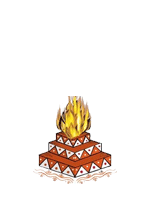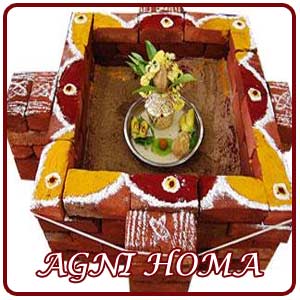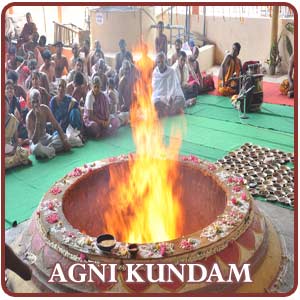 Agni -the Hindu diety is one among the chief of Gods
Agni -the Hindu diety is one among the chief of Gods
Agni the Hindu diety one among the chief of Gods is popularly known as the God of fire and also the acceptor of sacrifices. Till today right from the Vedic days Agni is considered as the Chief of Gods. In fact, the first verse of the Rig Veda is addressed to Agni, the fire God. "I praise Agni, the chosen Priest, God, minister of sacrifice...." During any Agni puja, sacrifices are made to the fire God for it is believed that Agni is a messenger from and to the other Gods and also he is believed to be the youngest and immortal of all Gods for everyday he is relit. Agni homa is one of the most significant ways of worship of the Hindus and a mode of communication with the Gods.The word "homa" is derived from the Sanskrit root "Hu" which means to offer, to present and to eat. Conducting an Agni homa is a religious ceremony which is performed in temples and newly built houses by which they worship the almighty through the use of a sacred fire.
 The Agni Homa is an ancient method -
The Agni Homa is an ancient method -
The Agni Homa is one ancient method which even dates back to the Vedic period of practice of worshipping the sacred fire. Agni has made the change into the Hindu pantheon of gods, without losing his importance. Rig Veda mentions about the significance of Agni along with Lord Varuna and Indra. Thus the Lord of the sacred fire, Agni acts as a communicator between the heaven and earth, the deities and the humans in association with Vedic sacrifices thereby taking offerings to the other immortal world through his sacred fire. Agni takes the pride of the first word of the first hymn of the Rig Veda. This Vedic God is represented by two heads namely one indicating immortality and the other marks an unknown symbol of life. There are no religious Hindu ceremonies in India which are performed without invoking the sacred fire or the fire God Agni for he acts as a messenger between the mortals and gods. Almost all the Vedic rituals involve Agni like that of the Agnicayana which is done by the piling of the fire altar, the Agnihotra and thus offering to Agni takes place.
 Process of a House Warming Ceremony -
Process of a House Warming Ceremony -

 In Ancient Period the Agni Homa has Witnessed Sacrifice of Animals
In Ancient Period the Agni Homa has Witnessed Sacrifice of Animals
-The various physiological functions of the body and its activities are kindled by the performance of the Agni homa. Even though today the fire sacrifice is a significant custom during a house warming ceremony in Hinduism, it used to be carried out even in a much elaborate ceremony in earlier days. In ancient period the Agni Homa has witnessed sacrifice of animals like horses and goats and other precious stones into the fire. But today it takes place in a much simplified form where rice or a kind of popery is commonly substituted instead of gems and other precious stones. But however the essential and the basic meaning of the Agni Homa remains the same. Based on the purpose of the ceremony, the Agni Homa is performed with bricks built to specific dimensions and shapes and this is called as Kunda and clarified butter acts as a fuel to this ceremony. However now this Kunda made of brick is mostly replaced by a metal kunda which is easily portable. Again depending on the occasion the shape of the fire container varies, like it either takes any one of the shapes like square, rectangular, round or triangular.
 Ceremony to the Fore God Agni is Performed with a Priest and the Guests
Ceremony to the Fore God Agni is Performed with a Priest and the Guests
-This ceremony to the fore God Agni is performed with a priest and the guests and the family members of the newly built house. The head of the family along with his female counterpart sit in front of the kunda while the mantras are recited by the priest and items like ghee, rice, herbs and foodstuffs are put into the sacrificial fire. Thus the Agni God takes the prayers and acts as a communicator between the Supreme power and the people who are performing the homa. Homas are performed for different purpose, say if one wants to pray for his health, then homas are performed and sacrifices are offered to the Sun God. If one wants to increase luck and general prosperity one could direct Agni to take the offerings to Ganesha and Lakshmi, two Divinities in charge of luck and fortune. In this way, during a homa many Deities may be propitiated with a specific focus on just one or two, depending on the purpose.
 Different Homas Conducted for Different Purpose
Different Homas Conducted for Different Purpose

This custom of offering sacrifices to the Agni God is not followed by the Hindu religion in India but also various other religions like Jews, Buddhism and Christianity.
According to the Hindu people the first start in new house is called as Griha Pravesh on an auspicious day fixed by a priest and
then the Agni homa is conducted and with the blessings of all the supreme Gods the members of the family start their life in the new house.


